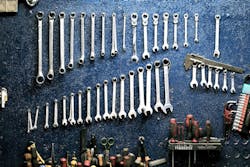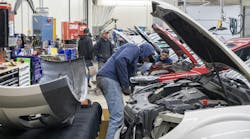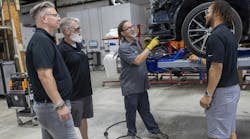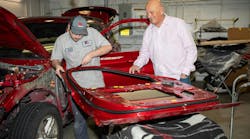Seven years ago, Shawn Stenson and six of his staff were sitting on an airplane on his way to Arizona. He was traveling along with other members of his BASF 20 Group. The group was on a mission to discover how they could provide rewards for their employees.
At that time, Stenson was the manager of a “straight-time” facility. In other words, he was running the operations normally, with his team separated into two main groups: front administrative staff and technicians. Stenson was proud because his shop was doing well, producing nearly $2.3 million in annual revenue.
But, Stenson eventually stepped off the plane in Arizona on that fateful day and changed the course of his business forever.
The 20 Group met with Tim Beal, owner of Beal’s Auto Body & Paint in Prescott, Ariz., and took a tour of his shop. Beal showed the group the ins and outs of the reception area and production department, and broke down his team pay plan, which his staff was happy with.
Blink! Stenson had a lightbulb go off inside his head. He was searching for a way to get his team working toward common goals and he thought to himself, “Beal’s body shop might just be the inspiration I needed.”
Stenson soon traveled the 1,751 miles back to Ontario and his body shop, CSN Kingston, and promptly got to work.
The Backstory
Stenson was running a shop that demanded a lot of hours worked by employees but was not truly rewarding them for their hard work.
He thought his problems would be solved if he simply initiated a team pay plan. He was wrong, however.
First, Stenson tried a pay plan with goals that were very difficult to achieve. At the time, his team was paid based on hours produced but it was not easily scalable when the team grew in size and capacity. The team’s hours produced were calculated and then if the team hit a certain level, they would receive a bonus. Yet, when some of the team was sick or had time off, those levels were harder to achieve.
Stenson noticed a few problem areas. He saw his team not tracking touch time and not caring if a vehicle was sitting in the shop at length. So, he decided to tweak his team pay plan.
The Problem
Stenson wanted to unite his employees under common goals but make it easier for them to achieve bonuses. All they needed was a push and some motivation. He was sick of having his staff operate as two separate entities, one on the administration side and one on the back end of the shop floor.
He also noticed an influx in administrative work as vehicles and repair procedures evolved over the years. As the repairs evolved, the front office staff needed to spend more time researching the OE repair procedures before even sending the car to the production department. What’s more, the focus in the collision repair industry was shifting toward thorough estimates and reducing supplement rates.
Stenson wanted to find a way to offer not just bonuses, but bonuses that were given when every single employee in the shop contributed to a sales goal.
“The work for the admin employees now is almost one-to-one with the technician,” Stenson says. “They have to look up repair procedures, look up parts, blueprint the vehicle, and create a repair plan all before completing an appraisal.”
The Solution
Stenson sat down and, within six months, created a new pay plan for his entire facility. During those six months, he consulted with other body shop owners, including other CSN Collision Repair operators. Stenson realized he needed to focus on creating a plan that had a solution in place in case a team member missed a lot of time or another team member worked extra overtime.
So, he developed a second team pay plan based on the same hours produced model, but this time, all hours produced counted toward the set, monthly goal. For instance, the team knows ahead of time, that they need to meet a goal of 150 hours produced per day, and then another 150 hours the next day and so on and so on. The number is tracked on a production board on the shop floor. As the team reaches closer to the monthly number of hours produced, everyone can start to estimate their monthly bonus. His staff are paid bi-weekly.
To assist the team in increasing hours produced, Stenson implemented SOPs. Soon, each step of the process had a standard operating procedure in case someone from another department needed to take over a job. Examples of those SOPs include one for disassembly, one for estimating and one for blueprinting. The shop staff are segmented based on skill set, like one technician exclusively focusing on disassembling a vehicle, but the SOPs make it easier for another staff to substitute for a team member if she or he was out of the shop that day.
Hours produced are all collected together toward the daily goal and count toward each individual technician, which spurred the CSN Kingston staff to want to keep pushing work through the shop.
The team is motivated to produce more hours to reach the daily hours produced goals and as a result, are paying closer attention to KPIs like cycle time and touch time. Now, the team knows that a lower cycle time will result in more hours and ultimately, more money.
CSN Kingston’s next step was focusing on creating an ideal culture. If the whole team was getting paid on what others were doing for work, then everyone needed a “can-do” attitude.
“One bad employee can ruin a team,” Stenson notes. “ We can’t have that with a team pay program. That person leaves and the rest of the staff has to pick up the slack left behind.”
Specifically, Stenson evolved his front office team. He created positions for each appraiser that would eliminate unnecessary back-and-forth between teammates. Now, a CSR has first contact with the customer and writes the walk-around estimate. The second appraiser will type up the estimate and research procedures, and the third appraiser will review appraisal and catalogue parts to order or send notes about it to the insurance company, the back-end of the shop and the customer. Ultimately, the three appraisers have more time to produce a thorough estimate and repair plan for the production department.
The front office team will sit down with the technicians and determine a sales goal by themselves. Stenson notes that he might coach them to choose a goal based on past performance but the decision ultimately is the staff’s decision. They’ll choose a sales percentage they want to reach for the new year. Once a sales goal is chosen, then the team will calculate how many hours they need to produce each month, and each day, to reach that bonus.
The Aftermath
Under the new plan, the team has met and exceeded every sales goal they’ve established. Since implementing the second team pay plan, Stenson’s shop has a key-to-key cycle time of 8.9 days and a production cycle time of 6.9 days. Before the plan, the shop produced $28.57 in sales per square foot and after the plan, produces $45.70 sales per square foot.
The new pay plan and team member shift has technicians working with one apprentice.
While this is mainly due to the technician shortage in the industry, the structure helps the team focus on the plan and one clear goal: get cars out the door.
The Takeaway
The biggest challenge when Stenson switched over was getting everyone on board with the new pay setup.
“If you work as a team, you can affect change,” Stenson says, “but it takes time for people to realize what they do and how instrumental it is.”
SHOP STATS:CSN Kingston Location: Kingston, Ontario. Operator: Pat Stenson Average Monthly Car Count: 133 Staff Size: 24 (12 admins, 12 techs) Shop Size: 8,750 square feet. Annual Revenue: $4.8 million




